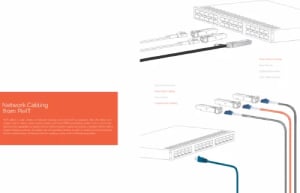8 Falsehoods of Fiber Patch Cables

What Are Fiber Optics?
Essentially, Fiber Optics are another type of network cable, but rather containing lines of copper, it consists of long strands of glass fiber. It is encased in insulated wiring.
Fiber Optics provide higher levels of bandwidth and can transmit data packets over very long distances.
The strands of glass are as thick as human hair. The center of these strands are known as the core, and the core provides the means in which the light can travel at very fast speeds. The glass that surrounds the core, is called the “cladding”.
There are two main types of Fiber Optic cabling:
- Single Mode:
This consists of “Wave Division Multiplexing” (WDM). WDM allows for varying wavelengths to be combined (which is known as “Multiplexing”) or separated (this is known as “De-Multiplexing”). Multiple streams of data packets can flow in a single light pulse.
- Multi-Mode:
This is composed of Light Emitting Diodes, also known as LEDs.
The Advantages of Fiber Optics
There are numerous benefits to Fiber Optics:
- It can support a very high network throughput. The cabling can come in as high as 100 Gbps.
- There is no need for signal boosters, because the light that is being transmitted can travel a very long distance without losing its strength.
- It is not susceptible to electromagnetic interference.
Despite these advantages, Fiber Optics are still poorly understood, and there are many myths that surround it.
The Myths of Fiber Optics Debunked
Myth #1: Fiber Optics are too expensive for my budget.
Actually, Fiber Optics are not exorbitantly expensive now and are very comparable in price to Ethernet cabling. In fact, many SMBs can now afford Fiber Optics. You will also achieve tremendous cost savings because light is being used instead of copper to transmit the flow of data packets. It requires less power consumption and equipment to maintain. In fact, one line of Fiber Optic cable can outlive 9 generations of copper cabling.
Myth #2: Because glass is used, Fiber Optics are not durable:
The misconception is that since glass can be easily broken, so can the Fiber Optic cabling. There are hundreds and hundreds of glass strands in a single cable line, thus making it very strong to withstand all sorts of environments. In fact, the military uses Fiber Optics quite extensively in the harshest of climates, and it can withstand over 200 pounds of pulling tension.
Myth #3: Fiber Optic cabling is dangerous:
Since light is used, there is minimal risk of a fire hazard, as opposed to Copper Cabling. There is also no risk when it comes to electromagnetic interference with other nearby electronic equipment.
Myth #4: The deployment can be burdensome and time consuming:
When Fiber Optic cabling first came out into commercial use in the 1990’s, the installation took quite a bit of time. However, since then, the technology has improved greatly, and now the deployment is rather quick. A prime advantage here is that it requires fewer routing points than copper cabling.
Myth #5: Glass cannot be bent:
Fiber Optic cabling can be bent in order to get to those hard to reach places. The introduction of multi-mode Fiber Optics (as discussed earlier) has increased the angle of bendability.
Myth #6: It does not support wireless networks:
The reality is that many wireless carriers (such as Verizon, ATT&T, T-Mobile, etc.) now rely upon Fiber Optic cabling because of its long-term durability and speed. It is also expected to fully support the 5G wireless networks.
Myth #7: It is less secure than copper:
The truth is that Fiber Optic cabling is much more secure. For example, it provides high levels of protection at the physical and data layers, and the network ports. This can reduce the risk of a Distributed Denial of Service (DDoS) attack from occurring.
Myth #8: It is difficult to manage after it has been installed:
A GUI based interface is used to manage the Fiber Optic network rather than the traditional Craft User Interface (CUI) that is required of copper cabling. This means that any issues or problems can be resolved very quickly, and most of the time, it does not require human intervention.
The Issues of Choosing OEM versus Third Party Optics
When deciding upon a Fiber Optic vendor, you can either go with an OEM or a third-party vendor. Here some of the key questions that usually get asked:
- What is the difference between the OEM versus a third-party brand?
There is really no difference between the two, but the OEM is going to be more expensive. The reason for this is that they private label their cabling.
- Is there a difference in the level of quality?
In reality, the level is the same (or perhaps even better) with a third-party brand. Even this type of Fiber Optic cabling has to go through quality control testing before it can be sold to the mass market.
- In the end, what should I go with?
This is dependent upon your own preferences. If you have the budget and feel that a private label brand will create a higher level of acceptance from your managers, then perhaps you should go with an OEM brand. But if you need to stay within a certain a dollar amount, then your best bet would to go with a third-party brand. With this, there will be a larger variety of Fiber Optic cabling to meet your needs.
Do you have questions or need further guidance when it comes to your Fiber Optic needs? Pivit Global has a wide variety of offerings from fiber to copper and everything in between. Reach out to us with your questions or sample pricing at hello@pivitglobal.com or 1-888-747-4847.
